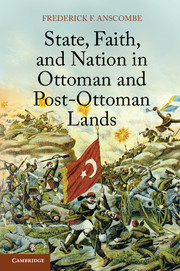Book contents
- Frontmatter
- Dedication
- Contents
- List of Maps and Images
- Acknowledgments
- Transliteration and Abbreviations
- Maps
- Introduction
- Part I The Ottoman Empire
- Part II From Ottoman to Post-Ottoman States
- 6 The Post-Ottoman Balkans
- 7 Post-Ottoman Turkey
- 8 The Post-Ottoman Arab Lands
- Part III Contemporary Post-Ottoman States
- Conclusion State, Faith, and Nation
- Bibliography
- Index
- References
8 - The Post-Ottoman Arab Lands
Published online by Cambridge University Press: 05 June 2014
- Frontmatter
- Dedication
- Contents
- List of Maps and Images
- Acknowledgments
- Transliteration and Abbreviations
- Maps
- Introduction
- Part I The Ottoman Empire
- Part II From Ottoman to Post-Ottoman States
- 6 The Post-Ottoman Balkans
- 7 Post-Ottoman Turkey
- 8 The Post-Ottoman Arab Lands
- Part III Contemporary Post-Ottoman States
- Conclusion State, Faith, and Nation
- Bibliography
- Index
- References
Summary
Of all the post-Ottoman countries, those of the Arab region had the most peculiar – and disadvantageous – beginnings. While the independent states of the Balkans and Turkey felt the need to develop or adapt forms of government to fill the vacuum left by the collapse of Ottoman rule, they at least had the chance to create regimes to control the new, nominally national, countries. Arab lands had little such opportunity. Rather than transiting from Ottoman provinces to post-Ottoman countries, they left the empire only to enter political purgatory, set officially on paths to the eventual recognition of independent nation-states but left in fact to practically open-ended British and French control. This twilit existence continued for roughly three decades, a period not of completely suspended animation but rather of misdevelopment or ultimately directionless drift. One of the most important issues that suggested such aimlessness was the choosing of a model that the construction of post-Ottoman supralocal identities should adopt.
During their European imperial interlude, the populations in the Middle East started with most of the disadvantages seen in the Balkans and Turkey but few of the opportunities to execute any of the measures taken elsewhere to build new senses of identity. As in other formerly Ottoman lands, there was little legitimate native leadership above the local level, and in some cases the European powers again proved decisive in establishing the authority of nonnative leaders (as they had done for Otto Wittelsbach and Georg Glücksburg in Greece, Alexander Battenberg and Ferdinand Saxe-Coburg-Gotha in Bulgaria, and Karl Hohenzollern-Sigmaringen and Ferdinand Hohenzollern in Romania, and almost did for Wilhelm zu Wied in Albania); rarely did they accept the rise of local notables to supralocal influence (as Miloš Obrenović in Serbia, Ahmet Zogu in Albania, and Mustafa Kemal in Turkey were able to do). Given that European control over the Middle East was established for the purpose of founding sustainable nation-states, nationalism was as logical or “natural” a choice of political ideology after the Ottoman collapse as it was elsewhere. Yet in the absence of true, legitimate native leadership and without fully autonomous regimes, no state existed capable of undertaking any serious nation-building program that would or could mold the populations within the European-drawn borders into distinct peoples.
- Type
- Chapter
- Information
- State, Faith, and Nation in Ottoman and Post-Ottoman Lands , pp. 197 - 218Publisher: Cambridge University PressPrint publication year: 2014
References
- 1
- Cited by



